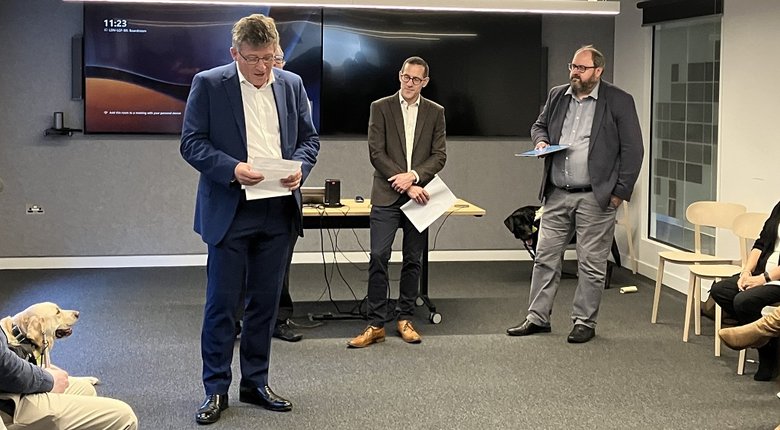RNIB tests four solutions to bring accessible voting one step closer

Image of RNIB CEO. Matt Stringer, chairing the discussion on how to make voting more accessible to blind and partially sighted people and our recent trial.
RNIB has trialled four different accessible voting solutions with blind and partially sighted voters, at an event supported by the Government and the Electoral Commission.
RNIB’s trial of accessible voting solutions – designed to allow blind and partially sighted people to vote independently and in secret – was attended on Monday by voters with sight loss as well as delegates from the Electoral Commission and the Department for Levelling Up, Housing and Communities (DLUHC) as well as other internal and external stakeholders.
We’ve been campaigning for a wider range of accessible voting solutions to be tested and made more easily available for many years.
We hear frequently from people with sight loss of how they have faced challenges in exercising their democratic right to cast a secret and independent vote, because the practical act of voting – making a cross in a specific location on a piece of paper – is fundamentally a visual exercise. You can read more about our research in our Turned Out Report 2022.
We’ve worked alongside the Electoral Commission and DLUHC to find solutions to ensure future elections are accessible for the 350,000 blind and partially sighted voters living in the UK.
Four accessible solutions, which were tested on Monday at our office in London, are a range of tactile and audio devices which allow people with sight loss to determine the order of the list of candidates and mark their desired box independently.
We tested four different solutions:
- An audio player with a tactile overlay that allows you to listen to the candidate list in the order they appear on the ballot paper, the plastic overlay can then be used to identify where to mark the paper ballot.
- A new type of tactile voting device (TVD), which is similar to the solution currently in place, with a new built-in audio capability. The device fits over the ballot paper to help you locate the voting boxes with buttons per candidate which, when pressed, will read out the corresponding candidate.
- A prototype template made of cardboard that can be placed over the ballot paper; this works in a similar way to the tactile voting device. A matching QR code can be linked to an audio recording of the candidates that can be accessed via a smartphone.
- Microsoft’s Seeing A.I. app, testing how the app can be used with a reference ballot paper to determine the order of the candidate list.
Nearly half of voters with sight loss are dissatisfied with the electoral process. While there needs to be major changes to the current system to improve voting experiences for blind and partially sighted people, these changes are not insurmountable. We are here today to take steps to make accessible voting a reality for blind and partially sighted people.
Thank you to all who attended our event, including Shaun McNally, Chief Executive Officer at the Electoral Commission, Paul Docker, Chair of the Accessibility of Elections Working Group, and those who volunteered their time and tested the devices for us. We couldn’t have collected such valuable information without the blind and partially sighted people who have supported this work and given their time to test the solutions.
I was impressed at the thought behind this session and the efforts being made to give me, and other deaf blind people like me, the chance to reclaim our independent right to vote in ways that make the process smooth and understandable without being complicated.
Everyone should be able to register and vote independently and in secret, but we know that many blind and partially sighted voters still face barriers to voting.
There have been significant improvements to the law which mean that innovation in elections is now possible, and yesterday’s event is testament to that. It was great to see the range of technology that might enable people with sight loss to have a better experience of voting and have their say independently. The results of the trial, and the experiences of those who took place, will play an important role in helping to make elections accessible for all.
The findings will provide a valuable body of evidence for our continued work to make sure elections become accessible to people with sight loss.
We look forward to continuing our engagement with the Electoral Commission and DLUHC to ensure the results from this trial inform future elections.





